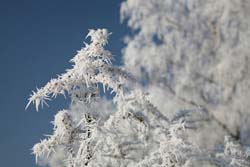New at FBTS: Salvia x 'Ultra Violet' Defies Heat and Cold

Sometimes Hell does freeze over. In the Rocky Mountain West, conditions can swing from hellishly hot, dry summers to freezing cold winters. Although many Salvias native to the Southwest are ideal for the sunbaked summers of Colorado, New Mexico and Utah, they have trouble surviving Zone 5 winters, which can include prolonged periods of frost, ice and snow.
So we greatly appreciate the cold hardiness as well as the drought resistance of one of our newest hybrid cultivars, Ultra Violet Hybrid Sage (Salvia lycioides x greggii ‘Ultra Violet’), which does just fine on the high plains and in the foothills of Zone 5b when temperatures drop to -20 degrees F.
A Happy Accident
Garden designers Scott Ogden and Lauren Springer Ogden, who are well known for their naturalistic style detailed in their 2008 book Plant-Driven Design. They discovered Ultra Violet Sage as an accidental hybrid in their Fort Collins, Colorado, garden. Happy hybrid surprises are common among S. greggii and its close relative Salvia microphylla.
Ultra Violet Sage is a cross between the blue-flowered Canyon Sage (Salvia lycioides) and a rose colored Autumn Sage (Salvia greggii). The result is intensely violet-to-purple flowers and dark green foliage.
Both Canyon Sage and Autumn Sage are short, growing no more than 36 inches tall. Whereas Canyon Sage blooms from spring into early summer, Autumn Sage begins in spring and continues into autumn. Ultraviolet falls in-between; it blooms from early summer into autumn.
We don’t invest in many patented plants that require licensing. However, this plant is so cold hardy, long blooming, and lovely that we couldn’t resist.
Care and Growth
Ultra Violet Sage needs full sun and requires regular watering until well established. It thrives in loamy soils whether lean or rich in nutrients from high-clay content – a common condition in many soils of the Rocky Mountain region.
Pruning of this shrubby sage should be done in spring when threat of frost is past. If pruned during cold weather, water may get into the stems and damage the plant’s future growth.
Butterflies and hummingbirds are drawn to Ultra Violet Sage, but rabbits and deer avoid it. This is good, because no matter how much you love wildlife, it is difficult to lose such a fragrant, pretty plant to wandering nibblers.
Salvia and Sustainability
In their 2011 book Waterwise Plants for Sustainable Gardens, the Ogdens cite Salvias as being an excellent choice for xeriscape, which is the art of creating colorful, drought-tolerant landscapes. You can peek into their book, which covers 200 drought-tolerant species, at the website of their publisher Timber Press.
Aside from transcending the heat and chill of Zone 5, Ultra Violet Sage is an excellent xeriscapic species and an example of how beauty and toughness can go hand in hand. Click here for more information about Salvias and xeriscape in our Everything Salvias Blog. More questions? Please contact us and we will be glad to help.

Comments
There are no comments yet.